Abstract
The COVID-19 pandemic has frightened people worldwide, and coronavirus has become the most commonly used phrase in recent years. Therefore, there is a need for a systematic literature review (SLR) related to Big Data applications in the COVID-19 pandemic crisis. The objective is to highlight recent technological advancements. Many studies emphasize the area of the COVID-19 pandemic crisis. Our study categorizes the many applications used to manage and control the pandemic. There is a very limited SLR prospective of COVID-19 with Big Data. Our SLR study picked five databases: Science direct, IEEE Xplore, Springer, ACM, and MDPI. Before the screening, following the recommendation, Preferred Reporting Items for Systematic Reviews and Meta Analyses (PRISMA) were reported for 893 studies from 2019, 2020 and until September 2021. After screening, 60 studies met the inclusion criteria through COVID-19 data statistics, and Big Data analysis was used as the search string. Our research’s findings successfully dealt with COVID-19 healthcare with risk diagnosis, estimation or prevention, decision making, and drug Big Data applications problems. We believe that this review study will motivate the research community to perform expandable and transparent research against the pandemic crisis of COVID-19.
1. Introduction
With the significant changes in social connections, health regulations, commerce, and work, the pandemic scenario COVID-19 affects billions people in every field. Researchers have found new means of combating a transnational digital pandemic that poses a significant danger to human civilization [1,2]. The beta coronavirus SARS-CoV-2 (SARS-CoV-2) produces COVID-19. A strange kind of pneumonia was initially identified in Wuhan, the Chinese capital of the Hubei Province, and reported to the WHO Wuhan office on 31 December 2019 [3,4]; since then, the virus has spread to 214 nations and territories [5].
As of 30 September 2021, there have been more than 262 million illnesses and 5.2 million deaths, and the World Health Organization has declared a pandemic. The breakout of COVID-19 is seen as the worst catastrophe globally since the World Wars. COVID-19 has infected 213 nations and territories with (confirmed) sick patients, and the total is growing steadily [6,7]. The COVID-19 pandemic was associated with a stressful effect. Multiple efforts have been undertaken to fight COVID-19 because of its broad dissemination. A partial quarantine zone in Dutch population in year 2020 has been established to limit the spread of the virus, and the healthcare system has been prepared to deal with a pandemic should it occur [8]. Although seasonal effects remain questionable, the initial infection rates decrease with hot temperatures. Figure 1 illustrates the percentage of patients with COVID-19 symptoms. The cough symptom was highest among affected people [9].
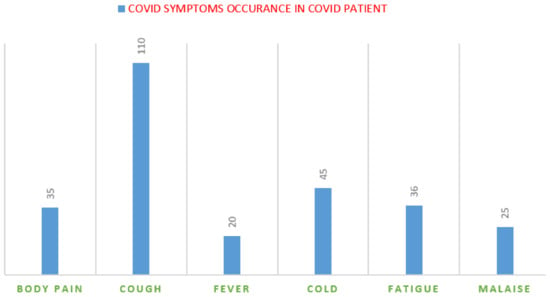
Figure 1.
COVID-19 symptoms in COVID-19 patient [10].
Artificial Intelligence is based on machine learning, data mining, Big Data, deep learning [11]. The data mining models are now applied to identify and predict various tasks [12], specifically for disease prediction [13]. Big Data might be used to track outbreaks of diseases in real-time. The number of new infections in the country and COVID-19 differs from other pandemics [14]. The Big Data concept creates new meaning and value from a large amount of available data. The evaluation and utilization of sufficient data for many operations is critically significant [15]. Big Data are available in structured and unstructured form for information retrieval [16] and information extraction [17]. Recently, Big Data grew significantly, with exponential growth due to data gathered through machine learning used for applications such as sales analytics [18], stock market prediction Big Data [19], food reviews through sentiment analysis [20], cloud computing [21], recommendation systems for movies [22], deep learning regarding leukemia diseases [23], fake profiles [24], flight web search analytics [25], Cricket match winning prediction [26] and IoT threads for predicting Denial of services attacks [27] by using Big Data frameworks.
Big Data is characterized by high volume, speed, variety, value, and integrity of information known, as detailed in Table 1. Digital health technology can aid complex human pandemic-related tactics and reactions [28,29].

Table 1.
Description of Big Data characteristics.
The expansion of the COVID-19 international pandemic has created a large amount of data that can substantially enhance our understanding of the Big Data research system. Big-data technology has been used to minimize pandemic dangers [30,31]. A COVID-19 cure could be further delayed due to potential viral genetic alterations. Acquisition of data in the medical sector raises the tendency to use Big Data analysis with machine learning algorithms as aids in early prediction [32], detection of schistosomiasis [33], osteoporosis prediction for trabecular bones [34], drug interaction diagnosis [35], ensemble techniques on detection of diabetic [36] and prediction of fake news [37].
Now, the massive quantity of information on the persons infected with this COVID-19 virus may be stored in the Big Data technologies. There are many different sources of Big Data. There are several sources that may be tapped into, including online social networks, mobile devices, Internet of Things-enabled devices, and publicly available data in various formats. Big Data technology has also been utilized to track contacts [38]. COVID-19 information on patients is contained inside Big Datasets [39]. A pandemic management multi-dimensional reference framework is meant to utilize massive data analytics regarding pandemics. The COVID-19 pandemic diffusion is challenging to model [40]. Figure 2 elaborates about Big Data and management of the COVID-19 pandemic.
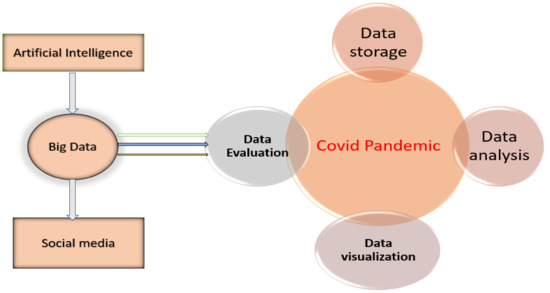
Figure 2.
Role of Big Data in the COVID-19 pandemic.
The systematic literature review aims to address the COVID-19 research in the context of Big Data applications and frameworks, and to identify research gaps. Our study further provides guidelines for future work related to Big Data for COVID-19 through deep learning. We analyzed 60 papers from the top journals and conferences conducted between the year 2019 to 2021.This review paper’s remaining sections are organized as follows. The research methodologies utilized in our study, including the research strategy, research objectives, and research questions, the processes used to conduct a systematic mapping, the findings of the preliminary research, and the quality evaluation and data extraction methods for each review topic are discussed in Section 2. Section 3 represent the results of each review question in detail. Section 4 contains the concluding remarks. In Section 5, suggestions are highlighted arising from this paper’s findings.
2. SLR Research Methodology
The primary objective of a systematic mapping study is to identify an arena for research and the amount and types of research and discoveries inside it. A researcher could examine the frequency of publications over time to determine trends. The identification of published research on the issue might be an additional objective. This section includes the search for relevant articles, the design, and the mapping of publications. Mapping research summarizes the present knowledge and identifies essential topics through a thorough literature review. The qualities and values of the technical systemic literature review for particular research contexts are discussed in this section [41]. This is not the objective of systematic mapping research because the papers are not thoroughly examined. Its primary focus is on the categorization, thematic analysis, and publication identification process of the research methodology, as explained in Figure 3.
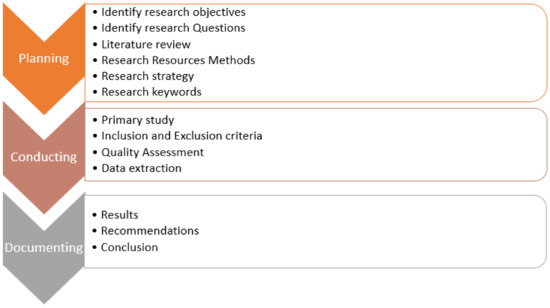
Figure 3.
Systematic literature review research methodology.
2.1. Research Objectives
A research question is a specific subject that the study will address. It is the foundation of systematic research and assists in developing a clearly defined research path. Choosing a study subject is the first stage in every research endeavor. A compelling research question is required to begin a research paper or thesis. It pinpoints exactly what you want to study and guides your efforts in the proper direction. The objectives are used to produce the research questions. In an SLR, the importance of choosing study participants cannot be emphasized enough. These make it easier for the researcher to stay on track. The research questions and motivations are described in Table 2. The study subjects have an impact on how a research plan is developed. As a result, the study questions for the SLR were thoroughly planned. This section includes a collection of research questions as well as justifications for them.

Table 2.
Research Questions and their motivation.
2.2. Research Resources and Methods
The IEEE Digital Library, ACM Digital Library, and Science Direct databases were used to locate the papers. Google Scholar was also used to find grey literature on the issue, such as white papers and technical studies. Google Scholar has been demonstrated to be a useful tool for carrying out bibliometric research. The Table 3 lists the research databases that we utilized to find literature for our research project.

Table 3.
Research resources.
Methods of research or strategies, procedures, and techniques for collecting data or evidence for analysis to reveal new data or to gain a better knowledge of an issue are illustrated in Table 4. These research methodologies have been employed in this review article.

Table 4.
Research methods.
2.3. Search String
The third stage of SLR consists in searching for suitable research studies. A search string was established for gathering published papers relating to the study themes. We performed a pilot search using precise terms, and we chose to limit the search string only to Big Data applications. However, we also leveraged COVID-19 effects on Big Data in the pilot search. Multiple search engines and digital libraries were used to gather information during Internet researches. The acquired results were carefully assembled to obtain the best information sources to answer the given research topics [41]. It was decided to use specific search engines and digital libraries based on their scientific content and relevance to the paper’s goals. As a result of the analysis, Science Direct and IEEE Xplore were employed, as well as the ACM, SL, and MDPI databases. Search engines and digital libraries may be used to find technical and scientific documents. The next step is to decide the strategies and search phrases to employ. A set of words was picked from the study questions to define the search string. Table 5 shows the terms selected from study questions to determine the search string.

Table 5.
Search String.
2.4. Search Keywords
We utilized an iterative technique to find keywords throughout the early phases of our study. To link our research questions to our research aims, we first gathered keywords from our research questions. The initial searches were meant to help us fine-tune our keyword selections. A list of keywords is stated in Table 6 may be found in the Keywords section.

Table 6.
Keywords used in research paper.
2.5. Result of Primary Studies
Once the research method and topic are finalized, the keywords-based primary research is conducted. The following results of an introductory study are listed in the percentages of the pie chart shown in Figure 4.
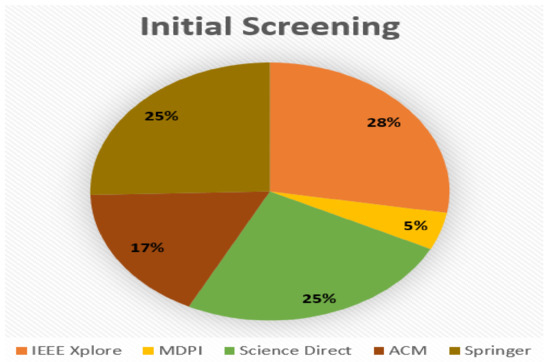
Figure 4.
Selected research papers from various research databases.
2.6. Study Selection
The selection process aimed to determine the articles most linked to the aims of the mapping research. When there was a document in several places, we only reviewed it once, following our search order. We followed the recommendation of Preferred Reporting Items for Systematic Reviews and Meta-Analyses (PRISMA) [42]. A total of 893 studies were reported from years 2019, 2020, and till September 2021 after the initial screening shown in Figure 4. One author obtained every article, which was then assessed by two other authors to see if the title, abstract and keywords are to be included. The two writers who conducted the article assessment discussed the papers, which received different ratings until an agreement was achieved. The other writers examined the final choices. After the articles were found, the first step was to remove obvious duplicates. Many of the studies identified during the inquiry had nothing to do with our conditions and were vague. We have done a lot of research to filter out publications unrelated to our research topics through a study selection procedure. Figure 5 depicts the phases of study selection and the activities that occurred throughout each study period, which shows the number of records included and excluded in each selection step. The primary focus of the search was COVID-19, which is quickly gaining traction among government officials, researchers, and scientists.
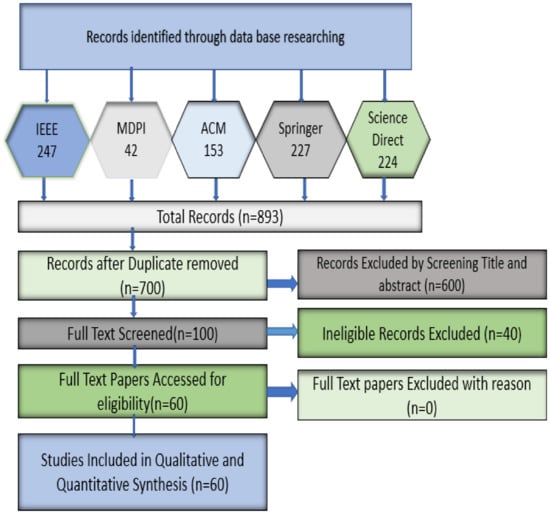
Figure 5.
Study selection process for SLR through the PRISMA framework [42].
There were 43 papers from journals and 17 from conferences after qualitative and quantitative screening. The percentage ratio is shown in the Figure 6.
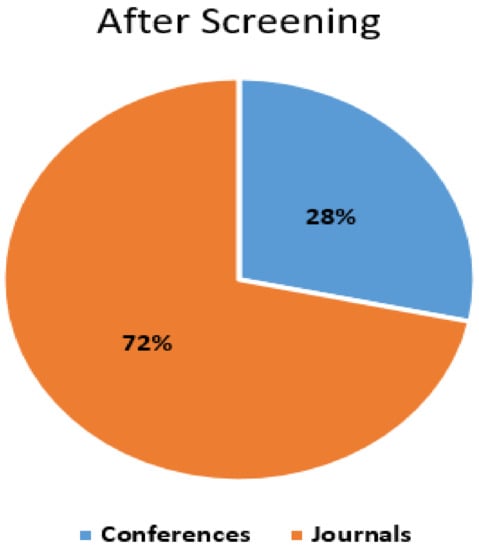
Figure 6.
Graphic distribution of selected papers by type of publication.
Figure 7 shows a bar graph of each database for the years 2020 and 2021 with the number of conference and journal papers. ACM contained three conference papers, which was the lowest among the five databases searched.
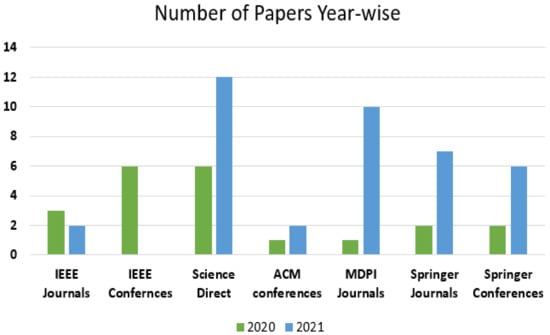
Figure 7.
Number of selected papers included by year.
Figure 8 shows the distributions of five databases including journal and conference papers. The science direct database had the maximum number selected, with 18 papers. The IEEE Xplore database contained 17 papers from conferences and journals.
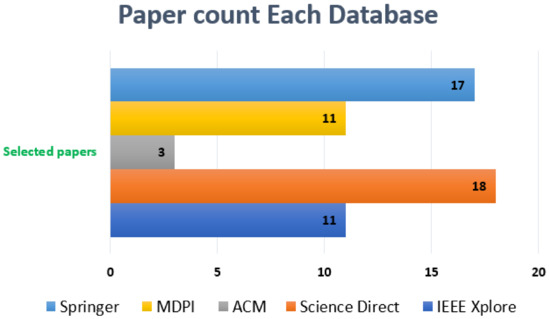
Figure 8.
Five databases’ paper count.
2.7. Inclusion Criteria
The inclusion criteria of study was based on five points as described in the Table 7.

Table 7.
Inclusion criteria.
2.8. Exclusion Criteria
The exclusion criteria for the current review paper are listed in Table 8.

Table 8.
Exclusion criteria.
2.9. Quality Assessment
Quality evaluation (QA) is widespread in systematic literature reviews, but it is less typical in systematic mapping research. After reviewing our papers, we focused on determining the research’s application for our outcomes. We looked at the scope of each inquiry to see if it aligned with our goals. This helped answer our research question. We examined each item to make sure it has clear instructions that clearly show what we need to accomplish. Table 9 depicts the quality assessment criteria of selected research papers. These criteria are based on four quality assessment questions (QAs):

Table 9.
Quality assessment of selected research paper.
- Do the picked articles correspond to the query conference or journal?
- Is there a blind review process for the selected study?
- Were the selected research papers acceptable and had meaningful information?
Queries for Quality Assurance (QA) must assess the nature of the investigation of each assertion and provide a quantifiable correlation between each proposition. Below are the scoring criteria.
- Acknowledge (A) = 2
- Some (S) = 1
- Conflict (C) = 0
2.10. Data Extraction
For data extraction, a variety of possible solutions to research questions were supplied. In fact, the type of data to be collected is mainly determined by the initial research subject. Important details include how the research’s design and methodology, as well as the qualitative and quantitative results, were accomplished, as well as when, where, and by whom the primary study was conducted. The relevant information from each major research in the sample was then collected, extracted, and selected in the next stage. The following extraction technique is available for each study topic’s extracted data.
3. Results
The findings of the systematic mapping questions are described in this section. Some papers were selected to serve as examples of each RQ’s outcome. They are relevant and provide a significant contribution to the learning of Big Data applications.
3.1. Selection Result
Out of the 893 thoroughly examined items, 833 have been deleted and 60 have been picked. In order to answer RQs, the obtained data were analyzed. The Table 3 is described the list of the selected publications, overall categorization findings and their quality certification.
3.1.1. RQ1: Role of Big Data Applications for Fighting the COVID-19 Pandemic
Geospatial techniques have recently been a buzzword in the fields of technology and research. Fast action is critical when the world is confronted with a global pandemic as severe as COVID-19. Big Data technology’s major purpose is to predict future trends based on present patterns, which involves substantial data collecting as well as technology to process and analyze large datasets [83].
Big Data applications assisted in strengthening the resistance to the global financial crisis’s consequence [95]. Big Data applications play an important role in handling such pandemic situations as predicting COVID-19 outbreaks and diagnosing COVID-19 cases and spreading patterns, as described below [76].
The capacity of large-scale data analyzers to forecast the outbreak played an important role in the fight against COVID-19. The pandemic prediction we evaluated is based on public datasets that may be utilized to describe geographical areas with probable breakouts. In Wuhan there was a first attempt to track traffic from and into the city in order to prevent the spread of COVID-19. Predicting a viral outbreak is vital to take safety steps and manage more aggressive cases in this pandemic [47].
This allows simulations to predict the path of the COVID-19 pandemic, for example to identify hazardous pandemic areas. The pandemic is projected using accessible data points, which puts the accuracy of the prediction into question owing to the uncertainty of the fitting due to lack of thorough inquiry [49]. Accuracy may be affected by various circumstances, including diseased cases, population, living situations, surroundings, and so on. During the current Big Data period, a large volume of data was created and collected from various rich data sources [60].
Real-time data intelligence facilitates COVID-19 surveillance. The need for Big Data was highlighted in real-time illness monitoring, including the creation of visuals for an outbreak, medical services, and hospital and contact screening [97].
Big Data is important for creating pandemic models that can precisely forecast and aid governments in evaluating the path of an outbreak. Due to the global economic slowdown, the COVID-19 pandemic exacerbated the plight of people. Impacts on the economy, the environment, and society are significant. The Figure 9 shows that COVID-19 is impacting different age groups. The aging profiles of a population of patients have been substantially and reveal unique levels of recovery and mortality [65].
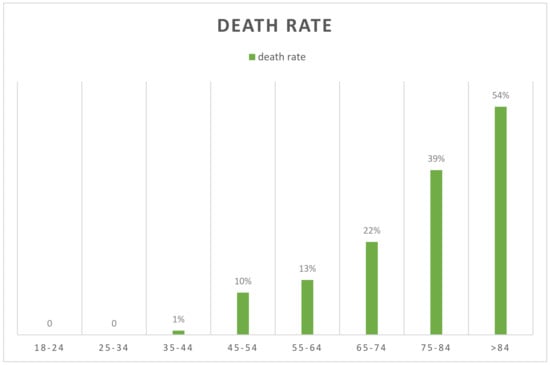
Figure 9.
COVID-19 death rate by age group.
Diagnosis of COVID-19 Cases by Big Data
Big Data can be used on the internet to track progress and public pandemic concerns, foresee the trend in pandemics, and warn early on in circumstances of public health in general. COVID-19 symptoms vary, but research focusing on the medical characteristics and signs of positive patients of COVID-19 are not fully identified. One of COVID-19′s most significant problems was to provide sufficient safety amid a pandemic crisis in the transport business [89]. As part the five significant technological contributions, Big Data technology relevance was examined as a tool to locate virus-prone areas. When COVID-19 is suspected, RT PCR is utilized to make the diagnosis. Depending on the conditions, the test results may take 24 h to several days [92]. Therefore, the number of cases suspected of COVID-19 has risen above the current test capacity in numerous countries. In response, a number of researchers have devised alternative techniques for identifying COVID-19 infection. A variety of clinical symptoms and signs, including chest computer tomography, therapeutic measures and medical records, have been obtained and tested in the clinic. The statistics were analyzed and the results were similar to those with the most frequent fever and dry cough symptoms reported by reference [70].
Health Care Decision Making
Big Data can help doctors make better decisions. Big Data is mainly aimed at the ability to find, and turn a huge quantity of data into usable information for clinicians and decision-makers. Using large-scale data in healthcare, patient care enhancement in healthcare organizations and the production of value for patients and value-building in medical organizations has come about in a wide range of areas. An efficient administration, analysis and interpretation of large amounts of data can offer new game-changing approaches for medical care. Data on this automatic detection challenge are extensive in view of the great number of COVID-19 occurrences and the lung photographs [54]. Big Data applications can aid physicians, patients, and pharmaceutical and health workers. Big Data analysis methods allow for four types of extraction: volume, variety, speed, and truthfulness. Advanced prediction and diagnostic technology have been created together with rapid developments in medical imaging [87].
3.1.2. RQ2 Big Data Application Framework for Forecasting and Monitoring the Pandemic
The main objective of the proposed framework is to bridge the gap between present healthcare and technology, by creating a COVID-19 model employing unique Big Data analysis approaches and tools. The model’s outcomes can be utilized to develop possible health system improvement initiatives elsewhere to improve the management of infected persons. Big Data has been used for corporate applications for a long time. Still, the technology quickly expands to other sectors, such as health care equipment, social media, and satellite imagery [102]. Computers have used numerous computer algorithms and techniques to tackle our problems throughout the years. Data are analyzed using Big Data approaches with spark and deep learning [78].
Proposed COVID-19 Framework
COVID-QF offers to improve injection and query efficiency for COVID-19 datasets. The COVID-QF includes three steps of input, index, stock and query. The suggested COVID-QF approach describes how many datasets can be used to perform complicated questions. COVID-QF uses the basic Apache Spark architecture to optimize and reduce processes [103]. Apache Spark is a data processing system with memory distribution that accomplishes jobs 100 times faster than other systems in a few steps; as shown in Figure 10 [31]. The CSS-COVID-19 use of Apache Spark improves the effectiveness of the regularly enhanced management of enormous corona viral disease data [104].

Figure 10.
COVID QF Framework.
Hadoop Distributed File System (HDFS)
In Hadoop the Hadoop Distributed File System manages enormous data collections efficiently. After dividing the data into small chunks, you can save your data in various tubes with the Google 2File System. It is a dispersed structure of documents that continuously runs in all the district record structures and can store vast amounts of data. In Figure 11, the HDFS architecture is described clearly. There are two nodes in HDFS—Data Nodes and Name Node of Specialist. These hubs inspect, compose, manufacture, and omit tasks [40]. OpenSource includes a name, domain, the author’s name, source quotation (if applicable), writing style, website features, and the source’s presence on social media [56].
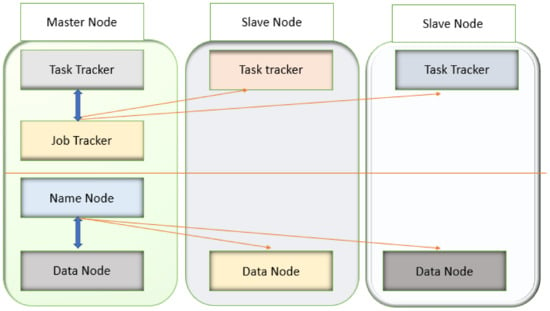
Figure 11.
Structure of Hadoop [28].
Apache Spark
Apache Spark is a fast processing open-source structure used for data review, as shown in Figure 12. Apache Spark has been developed by Apache as the de facto framework for Big Data analysis, increased memory programming and high-level libraries for machine-level study, Graph analytics, streaming and structured data processing. Over the past few decades, frameworks such as Apache Hadoop and Apache Spark through google Colab [105]. If an application has been installed in a Spark cluster, the program has all resources, except when users limit the accessible resources. The programming model is based on Hadoop Map Reduce and expands the Map-Reduce model effectively to more computations. The critical character of Spark is that the data are put in memory cluster computing, which increases the processing speed and makes it very useful for interactive programs and interactive queries with standard parallel techniques such as join and match. Apache Spark MLlib package provides machine learning algorithms [65].
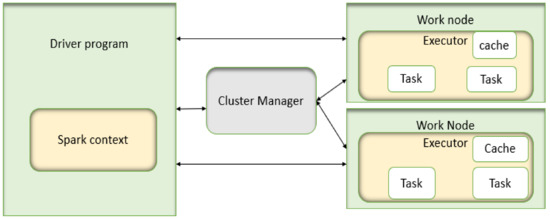
Figure 12.
Apache Spark Architecture [23].
3.1.3. RQ3 Big Data Application to Popular Issues during the Pandemic
Big Data can potentially combat the COVID-19 pandemic, as is clearly described in Table 10. However, it still faces several obstacles.

Table 10.
Popular Big Data applications in the pandemic.
4. Conclusions
The amount of data gathered from the international COVID-19 pandemic is growing significantly. After screening 60 articles included in the systematic review, our first question addressed the application of Big Data to fight the pandemic crisis of COVID-19 through diagnosis and health care decision-making systems. The second question had to do with risk diagnosis, estimation or prevention, decision-making, and drug applications for fighting COVID-19 efficiently. The study showed many analytical techniques and critical features. The third research question highlights some issues that might hinder COVID-19 data analysis technology. One hurdle is the safety of health data and the problems of patient safety, the problems of sharing data in business organizations, privacy and security, stimulus mechanism and integration, and rapid analysis of enormous datasets. Twenty-four papers were selected which addressed the third question and evaluated and identified some forward-looking themes in future studies and applications for assistance to stakeholders, such as government agencies, hospitals, patients, and autonomous employees. Finally, we analyzed and identified many prospective areas in future research and requests to help stakeholders such as governments, hospitals, patients, and responsible authorities make decisions and forecasts for the future.
5. Future Directions and Recommendations
Big Data technologies are a vital tool for battling COVID-19 in several appealing applications, ranging from pandemic monitoring, viral sensing and therapy, to diagnostic assistance. On the one hand, AI can provide a genuine range of COVID-19 treatments. COVID-19 has given several natural and typical test sites to estimate and minimize air pollution management possibilities. Because of various obstacles, including expenses and diminished COVID-19 test capacity, multiple countries have taken steps to prevent and reduce the spread of COVID-19. A vast and rising volume of data is described as Big Data, making it necessary to provide policy proposals for countries employing digital technology in combating COVID-19. Constant updates and modifications are essential to forecast and simulate the pandemic and post-pandemic era successfully, as well as developing COVID-19′s associated keywords and language. Ground measurements from meteorological stations are diurnally accurate. Rehabilitation rules can survive healthier recommendations if schistosomiasis has been employed and affected. Detecting vulnerabilities in current approaches is also needed. This systemic literature review provides a full report on research and studies. Deep learning has tackled the COVID-19 pandemic and is guided by future developments in COVID-19. Recent work inspired by deep learning models such as convolutional neural networks [107,108,109,110,111,112] could be applied to COVID-19 X Rays, CT Scan and MR images.
Author Contributions
All authors have contributed equally to this manuscript. All authors have read and agreed to the published version of the manuscript.
Funding
This research received no external funding.
Conflicts of Interest
The authors declare no conflict of interest.
References
- Pandey, N.; Pal, A. Impact of digital surge during COVID-19 pandemic: A viewpoint on research and practice. Int. J. Inf. Manag. 2020, 55, 102171. [Google Scholar]
- Althunibat, A.; Almaiah, M.A.; Altarawneh, F. Examining the Factors Influencing the Mobile Learning Applications Usage in Higher Education during the COVID-19 Pandemic. Electronics 2021, 10, 2676. [Google Scholar] [CrossRef]
- Gupta, M.; Jain, R.; Arora, S.; Gupta, A.; Javed Awan, M.; Chaudhary, G.; Nobanee, H. AI-enabled COVID-9 Outbreak Analysis and Prediction: Indian States vs. Union Territories. Comput. Mater. Contin. 2021, 67, 933–950. [Google Scholar] [CrossRef]
- Hu, B.; Guo, H.; Zhou, P.; Shi, Z.-L. Characteristics of SARS-CoV-2 and COVID-19. Nat. Rev. Microbiol. 2021, 19, 141–154. [Google Scholar] [CrossRef]
- Nishiura, H.; Jung, S.-m.; Linton, N.M.; Kinoshita, R.; Yang, Y.; Hayashi, K.; Kobayashi, T.; Yuan, B.; Akhmetzhanov, A.R. The extent of transmission of novel in Wuhan, China, 2020. J. Clin. Med. 2020, 9, 330. [Google Scholar] [CrossRef] [PubMed] [Green Version]
- Chang, M.-H.; Moonesinghe, R.; Truman, B.I. COVID-19 Hospitalization by Race and Ethnicity: Association with Chronic Conditions Among Medicare Beneficiaries, January 1–September 30, 2020. J. Racial Ethn. Health Disparities 2021, 8, 1–10. [Google Scholar] [CrossRef] [PubMed]
- Oraif, I.; Elyas, T. Applicability of collaborative work in the COVID-19 Era: Use of breakout groups in teaching L2 translation. Electronics 2021, 10, 2846. [Google Scholar] [CrossRef]
- Achterberg, M.; Dobbelaar, S.; Boer, O.D.; Crone, E.A. Perceived stress as mediator for longitudinal effects of the COVID-19 lockdown on wellbeing of parents and children. Sci. Rep. 2021, 11, 1–14. [Google Scholar]
- Jones, R.; Davis, A.; Stanley, B.; Julious, S.; Ryan, D.; Jackson, D.J.; Halpin, D.M.; Hickman, K.; Pinnock, H.; Quint, J.K. Risk predictors and symptom features of long COVID within a broad primary care patient population including both tested and untested patients. Pragmatic Obs. Res. 2021, 12, 93. [Google Scholar] [CrossRef]
- Struyf, T.; Deeks, J.J.; Dinnes, J.; Takwoingi, Y.; Davenport, C.; Leeflang, M.M.; Spijker, R.; Hooft, L.; Emperador, D.; Domen, J. Signs and symptoms to determine if a patient presenting in primary care or hospital outpatient settings has COVID-19. Cochrane Database Syst. Rev. 2021, 7, CD013665. [Google Scholar]
- Abdullah, A.; Awais, Y.; Awan, M.J.; Shehzad, M.F.; Ashraf, M. Fake news classification bimodal using convolutional neural network and long short-term memory. Int. J. Emerg. Technol. Learn. 2020, 11, 209–212. [Google Scholar]
- Ferooz, F.; Hassan, M.T.; Awan, M.J.; Nobanee, H.; Kamal, M.; Yasin, A.; Zain, A.M. Suicide bomb attack identification and analytics through data mining techniques. Electronics 2021, 10, 2398. [Google Scholar] [CrossRef]
- Nabeel, M.; Majeed, S.; Awan, M.J.; Muslih-ud-Din, H.; Wasique, M.; Nasir, R. Review on Effective Disease Prediction through Data Mining Techniques. Int. J. Electr. Eng. Inform. 2021, 13, 717–733. [Google Scholar] [CrossRef]
- Corsi, A.; de Souza, F.F.; Pagani, R.N.; Kovaleski, J.L. Big data analytics as a tool for fighting pandemics: A systematic review of literature. J. Ambient Intell. Humaniz. Comput. 2021, 12, 9163–9180. [Google Scholar] [CrossRef] [PubMed]
- Labrinidis, A.; Jagadish, H.V. Challenges and opportunities with big data. Proc. VLDB Endow. 2012, 5, 2032–2033. [Google Scholar] [CrossRef]
- Rehma, A.A.; Awan, M.J.; Butt, I. Comparison and Evaluation of Information Retrieval Models. VFAST Trans. Softw. Eng. 2018, 6, 7–14. [Google Scholar]
- Alam, T.M.; Awan, M.J. Domain analysis of information extraction techniques. Int. J. Multidiscip. Sci. Eng. 2018, 9, 1–9. [Google Scholar]
- Javed Awan, M.; Shafry Mohd Rahim, M.; Nobanee, H.; Yasin, A.; Ibrahim Khalaf, O.; Ishfaq, U. A Big Data Approach to Black Friday Sales. Intell. Autom. Soft Comput. 2021, 27, 785–797. [Google Scholar] [CrossRef]
- Javed Awan, M.; Shafry Mohd Rahim, M.; Nobanee, H.; Munawar, A.; Yasin, A.; Mohd Zain Azlanmz, A. Social Media and Stock Market Prediction: A Big Data Approach. Comput. Mater. Contin. 2021, 67, 2569–2583. [Google Scholar] [CrossRef]
- Ahmed, H.M.; Awan, M.J.; Khan, N.S.; Yasin, A.; Shehzad, H.M.F. Sentiment Analysis of Online Food Reviews using Big Data Analytics. Elem. Educ. Online 2021, 20, 827–836. [Google Scholar]
- Shin, S.; Kim, J.; Moon, C. Road Dynamic Object Mapping System Based on Edge-Fog-Cloud Computing. Electronics 2021, 10, 2825. [Google Scholar] [CrossRef]
- Awan, M.J.; Khan, R.A.; Nobanee, H.; Yasin, A.; Anwar, S.M.; Naseem, U.; Singh, V.P. A Recommendation Engine for Predicting Movie Ratings Using a Big Data Approach. Electronics 2021, 10, 1215. [Google Scholar] [CrossRef]
- Aftab, M.O.; Awan, M.J.; Khalid, S.; Javed, R.; Shabir, H. Executing Spark BigDL for Leukemia Detection from Microscopic Images using Transfer Learning. In Proceedings of the 2021 1st International Conference on Artificial Intelligence and Data Analytics (CAIDA), Riyadh, Saudi Arabia, 6–7 April 2021; IEEE: Piscataway, NJ, USA, 2021; pp. 216–220. [Google Scholar]
- Awan, M.J.; Khan, M.A.; Ansari, Z.K.; Yasin, A.; Shehzad, H.M.F. Fake Profile Recognition using Big Data Analytics in Social Media Platforms. Int. J. Comput. Appl. Technol. 2021, in press. [Google Scholar]
- Khalil, A.; Awan, M.J.; Yasin, A.; Singh, V.P.; Shehzad, H.M.F. Flight Web Searches Analytics through Big Data. Int. J. Comput. Appl. Technol. 2021, in press. [Google Scholar]
- Awan, M.J.; Gilani, S.A.H.; Ramzan, H.; Nobanee, H.; Yasin, A.; Zain, A.M.; Javed, R. Cricket Match Analytics Using the Big Data Approach. Electronics 2021, 10, 2350. [Google Scholar] [CrossRef]
- Awan, M.J.; Farooq, U.; Babar, H.M.A.; Yasin, A.; Nobanee, H.; Hussain, M.; Hakeem, O.; Zain, A.M. Real-Time DDoS Attack Detection System Using Big Data Approach. Sustainability 2021, 13, 10743. [Google Scholar] [CrossRef]
- Anuradha, J. A brief introduction on Big Data 5Vs characteristics and Hadoop technology. Procedia Comput. Sci. 2015, 48, 319–324. [Google Scholar]
- Tsai, C.-W.; Lai, C.-F.; Chao, H.-C.; Vasilakos, A.V. Big data analytics: A survey. J. Big Data 2015, 2, 1–32. [Google Scholar] [CrossRef] [Green Version]
- Wang, C.J.; Ng, C.Y.; Brook, R.H. Response to COVID-19 in Taiwan: Big data analytics, new technology, and proactive testing. JAMA 2020, 323, 1341–1342. [Google Scholar] [CrossRef]
- Jia, Q.; Guo, Y.; Wang, G.; Barnes, S.J. Big data analytics in the fight against major public health incidents (including COVID-19): A conceptual framework. Int. J. Environ. Res. Public Health 2020, 17, 6161. [Google Scholar] [CrossRef]
- Kavadi, D.P.; Patan, R.; Ramachandran, M.; Gandomi, A.H. Partial derivative nonlinear global pandemic machine learning prediction of covid 19. Chaos Solitons Fractals 2020, 139, 110056. [Google Scholar] [CrossRef] [PubMed]
- Ali, Y.; Farooq, A.; Alam, T.M.; Farooq, M.S.; Awan, M.J.; Baig, T.I. Detection of Schistosomiasis Factors Using Association Rule Mining. IEEE Access 2019, 7, 186108–186114. [Google Scholar] [CrossRef]
- Anam, M.; a/p Ponnusamy, V.; Hussain, M.; Waqas Nadeem, M.; Javed, M.; Guan Goh, H.; Qadeer, S. Osteoporosis Prediction for Trabecular Bone using Machine Learning: A Review. Comput. Mater. Contin. 2021, 67, 89–105. [Google Scholar] [CrossRef]
- Javed, R.; Saba, T.; Humdullah, S.; Jamail, N.S.M.; Awan, M.J. An Efficient Pattern Recognition Based Method for Drug-Drug Interaction Diagnosis. In Proceedings of the 2021 1st International Conference on Artificial Intelligence and Data Analytics (CAIDA), Riyadh, Saudi Arabia, 6–7 April 2021; IEEE: Piscataway, NJ, USA, 2021; pp. 221–226. [Google Scholar]
- Nagi, A.T.; Awan, M.J.; Javed, R.; Ayesha, N. A Comparison of Two-Stage Classifier Algorithm with Ensemble Techniques On Detection of Diabetic Retinopathy. In Proceedings of the 2021 1st International Conference on Artificial Intelligence and Data Analytics (CAIDA), Riyadh, Saudi Arabia, 6–7 April 2021; IEEE: Piscataway, NJ, USA, 2021; pp. 212–215. [Google Scholar]
- Awan, M.J.; Yasin, A.; Nobanee, H.; Ali, A.A.; Shahzad, Z.; Nabeel, M.; Zain, A.M.; Shahzad, H.M.F. Fake News Data Exploration and Analytics. Electronics 2021, 10, 2326. [Google Scholar] [CrossRef]
- Krech, S. Medical big data analytics and smart internet of things-enabled mobile-based health monitoring systems. Am. J. Med Res. 2019, 6, 31–36. [Google Scholar]
- Awotunde, J.B.; Jimoh, R.G.; Oladipo, I.D.; Abdulraheem, M.; Jimoh, T.B.; Ajamu, G.J. Big data and data analytics for an enhanced COVID-19 epidemic management. In Artificial Intelligence for COVID-19; Springer: Berlin/Heidelberg, Germany, 2021; pp. 11–29. [Google Scholar]
- Villanustre, F.; Chala, A.; Dev, R.; Xu, L.; Furht, B.; Khoshgoftaar, T. Modeling and tracking Covid-19 cases using Big Data analytics on HPCC system platform. J. Big Data 2021, 8, 1–24. [Google Scholar] [CrossRef] [PubMed]
- Hussain, M.; Javed, W.; Hakeem, O.; Yousafzai, A.; Younas, A.; Awan, M.J.; Nobanee, H.; Zain, A.M. Blockchain-Based IoT Devices in Supply Chain Management: A Systematic Literature Review. Sustainability 2021, 13, 13646. [Google Scholar] [CrossRef]
- Moher, D.; Liberati, A.; Tetzlaff, J.; Altman, D.G.; Group, P. Preferred reporting items for systematic reviews and meta-analyses: The PRISMA statement. PLoS Med. 2009, 6, e1000097. [Google Scholar] [CrossRef] [PubMed] [Green Version]
- Pham, Q.-V.; Nguyen, D.C.; Huynh-The, T.; Hwang, W.-J.; Pathirana, P.N. Artificial Intelligence (AI) and Big Data for Coronavirus (COVID-19) Pandemic: A Survey on the State-of-the-Arts. IEEE Access 2020, 8, 130820–130839. [Google Scholar] [CrossRef]
- Martsenyuk, V.; Bernas, M.; Klos-Witkowska, A. Two-Strain COVID-19 Model Using Delayed Dynamic System and Big Data. IEEE Access 2021, 9, 113866–113878. [Google Scholar] [CrossRef]
- Chen, H.; Zhu, Z.; Qi, F.; Ye, Y.; Liu, Z.; Sun, M.; Jin, J. Country image in COVID-19 pandemic: A case study of China. IEEE Trans. Big Data 2020, 7, 81–92. [Google Scholar] [CrossRef]
- Dash, S.; Chakraborty, C.; Giri, S.K.; Pani, S.K.; Frnda, J. BIFM: Big-data driven intelligent forecasting model for COVID-19. IEEE Access 2021, 9, 97505–97517. [Google Scholar] [CrossRef]
- Benreguia, B.; Moumen, H.; Merzoug, M.A. Tracking covid-19 by tracking infectious trajectories. IEEE Access 2020, 8, 145242–145255. [Google Scholar] [CrossRef]
- Leung, C.K.; Chen, Y.; Hoi, C.S.; Shang, S.; Cuzzocrea, A. Machine learning and OLAP on big COVID-19 data. In Proceedings of the 2020 IEEE International Conference on Big Data (Big Data), Virtual Event, 10–13 December 2020; IEEE: Piscataway, NJ, USA, 2020; pp. 5118–5127. [Google Scholar]
- Leung, C.K.; Chen, Y.; Shang, S.; Deng, D. Big data science on COVID-19 data. In Proceedings of the 2020 IEEE 14th International Conference on Big Data Science and Engineering (BigDataSE), Guangzhou, China, 29 December 2020–1 January 2021; IEEE: Piscataway, NJ, USA, 2021; pp. 14–21. [Google Scholar]
- Zeng, P.; Yang, K.; Chen, S. Using Big Data to Monitor the Impact of the COVID-19 Epidemic on Notifiable Diseases Reported in China. In Proceedings of the 2020 6th International Conference on Big Data and Information Analytics (BigDIA), Shenzhen, China, 4–6 December 2020; IEEE: Piscataway, NJ, USA, 2020; pp. 138–141. [Google Scholar]
- Chen, Y.; Leung, C.K.; Shang, S.; Wen, Q. Temporal data analytics on COVID-19 data with ubiquitous computing. In Proceedings of the 2020 IEEE Intl Conf on Parallel & Distributed Processing with Applications, Big Data & Cloud Computing, Sustainable Computing & Communications, Social Computing & Networking (ISPA/BDCloud/SocialCom/SustainCom), Exeter, UK, 17–19 December 2020; IEEE: Piscataway, NJ, USA, 2020; pp. 958–965. [Google Scholar]
- Leung, C.K.; Chen, Y.; Hoi, C.S.; Shang, S.; Wen, Y.; Cuzzocrea, A. Big data visualization and visual analytics of COVID-19 data. In Proceedings of the 2020 24th International Conference Information Visualisation (IV), Melbourne, VIC, Australia, 7–11 September 2020; IEEE: Piscataway, NJ, USA, 2020; pp. 415–420. [Google Scholar]
- Melenli, S.; Topkaya, A. Real-time maintaining of social distance in covid-19 environment using image processing and big data. In Proceedings of the 2020 Innovations in Intelligent Systems and Applications Conference (ASYU), Istanbul, Turkey, 15–17 October 2020; IEEE: Piscataway, NJ, USA, 2020; pp. 1–5. [Google Scholar]
- Million, M.; Gautret, P.; Colson, P.; Roussel, Y.; Dubourg, G.; Chabriere, E.; Honore, S.; Rolain, J.-M.; Fenollar, F.; Fournier, P.-E. Clinical efficacy of chloroquine derivatives in COVID-19 infection: Comparative meta-analysis between the big data and the real world. New Microbes New Infect. 2020, 38, 100709. [Google Scholar] [CrossRef] [PubMed]
- Li, X.; Zhao, Z.; Liu, F. Big data assimilation to improve the predictability of COVID-19. Geogr. Sustain. 2020, 1, 317–320. [Google Scholar] [CrossRef]
- Ma, K.S.-K.; Tsai, S.-Y. Big Data-driven personal protective equipment stockpiling framework under Universal Healthcare for Disease Control and Prevention in the COVID-19 era. Int. J. Surg. 2020, 79, 290. [Google Scholar] [CrossRef]
- Xue, F.; Li, X.; Zhang, T.; Hu, N. Stock market reactions to the COVID-19 pandemic: The moderating role of corporate big data strategies based on Word2Vec. Pac. Basin Financ. J. 2021, 68, 101608. [Google Scholar] [CrossRef]
- Giacalone, M.; Sinitò, D.; Calciano, M.; Santarcangelo, V. A Novel Big Data Approach for Record and Represent Compliance in the Covid-19 Era. Big Data Res. 2021, 100290. [Google Scholar] [CrossRef]
- Amen, B.; Faiz, S.; Do, T.-T. Big Data Directed Acyclic Graph Model for Real-time COVID-19 Twitter Stream Detection. Pattern Recognit. 2021, 123, 108404. [Google Scholar] [CrossRef]
- Azzaoui, A.E.; Singh, S.K.; Park, J.H. SNS Big Data Analysis Framework for COVID-19 Outbreak Prediction in Smart Healthy City. Sustain. Cities Soc. 2021, 71, 102993. [Google Scholar] [CrossRef] [PubMed]
- Chew, A.W.Z.; Pan, Y.; Wang, Y.; Zhang, L. Hybrid deep learning of social media big data for predicting the evolution of COVID-19 transmission. Knowl. Based Syst. 2021, 233, 107417. [Google Scholar] [CrossRef]
- Zhang, H.; Li, P.; Zhang, Z.; Li, W.; Chen, J.; Song, X.; Shibasaki, R.; Yan, J. Epidemic versus economic performances of the COVID-19 lockdown in Japan: A Mobility Data Analysis. Cities 2021, 120, 103502. [Google Scholar] [CrossRef] [PubMed]
- Zhou, C.; Su, F.; Pei, T.; Zhang, A.; Du, Y.; Luo, B.; Cao, Z.; Wang, J.; Yuan, W.; Zhu, Y. COVID-19: Challenges to GIS with big data. Geogr. Sustain. 2020, 1, 77–87. [Google Scholar] [CrossRef]
- Han, H. Exploring the association between compliance with measures to prevent the spread of COVID-19 and big five traits with Bayesian generalized linear model. Personal. Individ. Differ. 2021, 176, 110787. [Google Scholar] [CrossRef] [PubMed]
- Shang, W.-L.; Chen, J.; Bi, H.; Sui, Y.; Chen, Y.; Yu, H. Impacts of COVID-19 pandemic on user behaviors and environmental benefits of bike sharing: A big-data analysis. Appl. Energy 2021, 285, 116429. [Google Scholar] [CrossRef] [PubMed]
- Shi, F.; Wei, Y.; Xia, L.; Shan, F.; Mo, Z.; Yan, F.; Shen, D. Lung volume reduction and infection localization revealed in Big data CT imaging of COVID-19. Int. J. Infect. Dis. 2021, 102, 316–318. [Google Scholar] [CrossRef]
- Guraya, S.Y. Transforming laparoendoscopic surgical protocols during the COVID-19 pandemic; big data analytics, resource allocation and operational considerations. Int. J. Surg. 2020, 80, 21–25. [Google Scholar] [CrossRef]
- Haimed, A.M.A.; Saba, T.; Albasha, A.; Rehman, A.; Kolivand, M. Viral reverse engineering using Artificial Intelligence and big data COVID-19 infection with Long Short-term Memory (LSTM). Environ. Technol. Innov. 2021, 22, 101531. [Google Scholar] [CrossRef] [PubMed]
- Qiu, H.-J.; Yuan, L.-X.; Wu, Q.-W.; Zhou, Y.-Q.; Zheng, R.; Huang, X.-K.; Yang, Q.-T. Using the internet search data to investigate symptom characteristics of COVID-19: A big data study. World J. Otorhinolaryngol. Head Neck Surg. 2020, 6, S40–S48. [Google Scholar] [CrossRef]
- Ma, K.S.-K. Integrating travel history via big data analytics under universal healthcare framework for disease control and prevention in the COVID-19 pandemic. J. Clin. Epidemiol. 2021, 130, 147. [Google Scholar] [CrossRef]
- Yao, H.; Liu, W.; Wu, C.-H.; Yuan, Y.-H. The imprinting effect of SARS experience on the fear of COVID-19: The role of AI and big data. Socio-Econ. Plan. Sci. 2021, 78, 101086. [Google Scholar] [CrossRef] [PubMed]
- Xu, W.; Chen, C. Research on the Influencing Factors and Management Countermeasures of College Students’ Sense of Security under the Environment of Big Data-an Empirical Analysis based on the Event of COVID-19. In Proceedings of the 2020 The 3rd International Conference on Big Data and Education, London, UK, 1–3 April 2020; Association for Computing Machinery: New York, NY, USA, 2020; pp. 21–25. [Google Scholar]
- Ren, W. A Study on College Graduates’ Employment Problem in The Context of Big Data Based on the Event of COVID-19. In Proceedings of the 2021 4th International Conference on Big Data and Education, London, UK, 3–5 February 2021; Association for Computing Machinery: New York, NY, USA, 2021; pp. 88–91. [Google Scholar]
- Loutfi, M.; Tibau, M.; Siqueira, S.W.M.; Nunes, B.P. CovidTrends: Identifying Behaviors during the COVID-19 Pandemic: An Analysis based on Google Trends and News. In Proceedings of the XVII Brazilian Symposium on Information Systems, Uberlândia, Brazil, 7–10 June 2021; Association for Computing Machinery: New York, NY, USA, 2021; pp. 1–8. [Google Scholar]
- Chen, Y.; Biswas, M.I. Turning Crisis into Opportunities: How a Firm Can Enrich Its Business Operations Using Artificial Intelligence and Big Data during COVID-19. Sustainability 2021, 13, 12656. [Google Scholar] [CrossRef]
- Jung, H.-S.; Yoon, H.-H.; Song, M.-K. A Study on Dining-Out Trends Using Big Data: Focusing on Changes since COVID-19. Sustainability 2021, 13, 11480. [Google Scholar] [CrossRef]
- Gao, Y.; Sun, D.; Zhang, J. Study on the Impact of the COVID-19 Pandemic on the Spatial Behavior of Urban Tourists Based on Commentary Big Data: A Case Study of Nanjing, China. ISPRS Int. J. Geo-Inf. 2021, 10, 678. [Google Scholar] [CrossRef]
- Awan, M.J.; Bilal, M.H.; Yasin, A.; Nobanee, H.; Khan, N.S.; Zain, A.M. Detection of COVID-19 in Chest X-ray Images: A Big Data Enabled Deep Learning Approach. Int. J. Environ. Res. Public Health 2021, 18, 10147. [Google Scholar] [CrossRef] [PubMed]
- Huang, H.; Chen, W.; Xie, T.; Wei, Y.; Feng, Z.; Wu, W. The Impact of Individual Behaviors and Governmental Guidance Measures on Pandemic-Triggered Public Sentiment Based on System Dynamics and Cross-Validation. Int. J. Environ. Res. Public Health 2021, 18, 4245. [Google Scholar] [CrossRef]
- Lu, D.; Mao, W.; Zheng, L.; Xiao, W.; Zhang, L.; Wei, J. Ambient PM2.5 Estimates and Variations during COVID-19 Pandemic in the Yangtze River Delta Using Machine Learning and Big Data. Remote Sens. 2021, 13, 1423. [Google Scholar] [CrossRef]
- Sun, X.; Gao, J.; Liu, B.; Wang, Z. Big Data-Based Assessment of Political Risk along the Belt and Road. Sustainability 2021, 13, 3935. [Google Scholar] [CrossRef]
- Alam, F.; Almaghthawi, A.; Katib, I.; Albeshri, A.; Mehmood, R. iResponse: An AI and IoT-Enabled Framework for Autonomous COVID-19 Pandemic Management. Sustainability 2021, 13, 3797. [Google Scholar] [CrossRef]
- Alsunaidi, S.J.; Almuhaideb, A.M.; Ibrahim, N.M.; Shaikh, F.S.; Alqudaihi, K.S.; Alhaidari, F.A.; Khan, I.U.; Aslam, N.; Alshahrani, M.S. Applications of Big Data Analytics to Control COVID-19 Pandemic. Sensors 2021, 21, 2282. [Google Scholar] [CrossRef]
- Kim, D.; Yun, J.; Kim, K.; Lee, S. A Comparative Study of the Robustness and Resilience of Retail Areas in Seoul, Korea before and after the COVID-19 Outbreak, Using Big Data. Sustainability 2021, 13, 3302. [Google Scholar] [CrossRef]
- Bragazzi, N.L.; Dai, H.; Damiani, G.; Behzadifar, M.; Martini, M.; Wu, J. How Big Data and Artificial Intelligence Can Help Better Manage the COVID-19 Pandemic. Int. J. Environ. Res. Public Health 2020, 17, 3176. [Google Scholar] [CrossRef]
- Dong, J.; Wu, H.; Zhou, D.; Li, K.; Zhang, Y.; Ji, H.; Tong, Z.; Lou, S.; Liu, Z. Application of Big Data and Artificial Intelligence in COVID-19 Prevention, Diagnosis, Treatment and Management Decisions in China. J. Med Syst. 2021, 45, 1–11. [Google Scholar] [CrossRef] [PubMed]
- Huang, F.; Ding, H.; Liu, Z.; Wu, P.; Zhu, M.; Li, A.; Zhu, T. How fear and collectivism influence public’s preventive intention towards COVID-19 infection: A study based on big data from the social media. BMC Public Health 2020, 20, 1–9. [Google Scholar] [CrossRef]
- Iandolo, F.; Loia, F.; Fulco, I.; Nespoli, C.; Caputo, F. Combining Big Data and Artificial Intelligence for Managing Collective Knowledge in Unpredictable Environment—Insights from the Chinese Case in Facing COVID-19. J. Knowl. Econ. 2020, 12, 1982–1996. [Google Scholar] [CrossRef]
- Grybauskas, A.; Pilinkienė, V.; Stundžienė, A. Predictive analytics using Big Data for the real estate market during the COVID-19 pandemic. J. Big Data 2021, 8, 1–20. [Google Scholar] [CrossRef] [PubMed]
- Sadowski, A.; Galar, Z.; Walasek, R.; Zimon, G.; Engelseth, P. Big data insight on global mobility during the Covid-19 pandemic lockdown. J. Big Data 2021, 8, 1–33. [Google Scholar] [CrossRef] [PubMed]
- Santosh, K.; Ghosh, S. Covid-19 Imaging Tools: How Big Data is Big? J. Med. Syst. 2021, 45, 1–8. [Google Scholar] [CrossRef] [PubMed]
- Ramanathan, S.; Ramasundaram, M. Accurate computation: COVID-19 rRT-PCR positive test dataset using stages classification through textual big data mining with machine learning. J. Supercomput. 2021, 77, 7074–7088. [Google Scholar] [CrossRef]
- Pillai, S.V.; Kumar, R.S. The role of data-driven artificial intelligence on COVID-19 disease management in public sphere: A review. Decision 2021, 1–15. [Google Scholar] [CrossRef]
- Nafea, I. Big Data Analytics Model for Preventing the Spread of COVID-19 During Hajj Using the Proposed Smart Hajj Application. In Advances in Intelligent Systems and Computing, Proceedings of the International Conference of Reliable Information and Communication Technology, Malaysia, Malaysia, 21–22 December 2020; Springer: Berlin, Germany, 2020; pp. 475–484. [Google Scholar]
- Mohanty, S.; Sharma, R.; Saxena, M.; Saxena, A. Heuristic approach towards COVID-19: Big data analytics and classification with natural language processing. In Data Analytics and Management; Springer: Berlin, Germany, 2021; pp. 775–791. [Google Scholar]
- Cárdenas, P.; Obara, B.; Ivrissimtzis, I.; Kureshi, I.; Theodoropoulos, G. Big Data for National Security in the Era of COVID-19. In Proceedings of the International Conference on Computational Science, Krakow, Poland, 16–18 June 2021; Springer: Berlin, Germany, 2021; pp. 68–82. [Google Scholar]
- Zheng, M. Surveillance and Disease Control in COVID-19: Big Data Application in Public Health. In Proceedings of the International Conference on Applications and Techniques in Cyber Security and Intelligence, Fuyang, China, 19–21 June 2021; Springer: Berlin/Heidelberg, Germany, 2021; pp. 565–570. [Google Scholar]
- Smaldone, F.; D’Arco, M.; Marino, V. I Am Free to Be in a Grocery Store: Profiling Consumers’ Spending During Covid-19 Pandemic via Big Data Market Basket Analysis. In Proceedings of the National Brand and Private Label Marketing Conference, Barcelona, Spain, 22–23 June 2021; Springer: Berlin, Germany, 2021; pp. 47–54. [Google Scholar]
- Marrazzo, V. The Implementation and Use of Technologies and Big Data by Local Authorities During the Covid-19 Pandemic. In Proceedings of the International Research & Innovation Forum, online, 7–9 April 2021; Springer: Berlin, Germany, 2021; pp. 295–304. [Google Scholar]
- Liu, J. An Assessment on the Response of China and America During the Covid-19 Pandemic in Cultural Perspective--Based on Big Data Analysis. In Proceedings of the International Conference on Applications and Techniques in Cyber Security and Intelligence, Fuyang, China, 19–21 June 2021; Springer: Berlin, Germany, 2021; pp. 632–639. [Google Scholar]
- Xia, Y.; Hu, W. Impact of COVID-19 attention on pharmaceutical stock prices based on internet search data. In Proceedings of the International conference on Big Data Analytics for Cyber-Physical-Systems, Shanghai, China, 28–29 December 2019; Springer: Singapore, 2020; pp. 1213–1220. [Google Scholar]
- Ahmed, I.; Ahmad, M.; Jeon, G.; Piccialli, F. A framework for pandemic prediction using big data analytics. Big Data Res. 2021, 25, 100190. [Google Scholar] [CrossRef]
- Khashan, E.A.; Eldesouky, A.I.; Fadel, M.; Elghamrawy, S.M. A big data based framework for executing complex query over Covid-19 datasets (Covid-QF). arXiv 2020, arXiv:2005.12271. [Google Scholar]
- Elmeiligy, M.A.; Desouky, A.I.E.; Elghamrawy, S.M. A multi-dimensional big data storing system for generated Covid-19 large-scale data using Apache Spark. arXiv 2020, arXiv:2005.05036. [Google Scholar]
- Awan, M.; Rahim, M.; Salim, N.; Ismail, A.; Shabbir, H. Acceleration of knee MRI cancellous bone classification on google colaboratory using convolutional neural network. Int. J. Adv. Trends Comput. Sci. 2019, 8, 83–88. [Google Scholar] [CrossRef]
- Awan, M.J.; Masood, O.A.; Mohammed, M.A.; Yasin, A.; Zain, A.M.; Damaševičius, R.; Abdulkareem, K.H. Image-Based Malware Classification Using VGG19 Network and Spatial Convolutional Attention. Electronics 2021, 10, 2444. [Google Scholar] [CrossRef]
- Awan, M.J.; Rahim, M.S.M.; Salim, N.; Mohammed, M.A.; Garcia-Zapirain, B.; Abdulkareem, K.H. Efficient Detection of Knee Anterior Cruciate Ligament from Magnetic Resonance Imaging Using Deep Learning Approach. Diagnostics 2021, 11, 105. [Google Scholar] [CrossRef]
- Awan, M.J.; Raza, A.; Yasin, A.; Shehzad, H.M.F.; Butt, I. The Customized Convolutional Neural Network of Face Emotion Expression Classification. Ann. Rom. Soc. Cell Biol. 2021, 25, 5296–5304. [Google Scholar]
- Mujahid, A.; Awan, M.J.; Yasin, A.; Mohammed, M.A.; Damaševičius, R.; Maskeliūnas, R.; Abdulkareem, K.H. Real-Time Hand Gesture Recognition Based on Deep Learning YOLOv3 Model. Appl. Sci. 2021, 11, 4164. [Google Scholar] [CrossRef]
- Mubashar, R.; Javed Awan, M.; Ahsan, M.; Yasin, A.; Partap singh, V. Efficient Residential Load Forecasting using Deep Learning Approach. Int. J. Comput. Appl. Technol. 2021, (in press). [Google Scholar]
- Awan, M.J.; Rahim, M.S.M.; Salim, N.; Rehman, A.; Nobanee, H.; Shabir, H. Improved Deep Convolutional Neural Network to Classify Osteoarthritis from Anterior Cruciate Ligament Tear Using Magnetic Resonance Imaging. J. Pers. Med. 2021, 11, 1163. [Google Scholar] [CrossRef]
- Ali, S.F.; Aslam, A.S.; Awan, M.J.; Yasin, A.; Damaševičius, R. Pose Estimation of Driver’s Head Panning Based on Interpolation and Motion Vectors under a Boosting Framework. Appl. Sci. 2021, 11, 11600. [Google Scholar] [CrossRef]
Publisher’s Note: MDPI stays neutral with regard to jurisdictional claims in published maps and institutional affiliations. |
© 2021 by the authors. Licensee MDPI, Basel, Switzerland. This article is an open access article distributed under the terms and conditions of the Creative Commons Attribution (CC BY) license (https://creativecommons.org/licenses/by/4.0/).